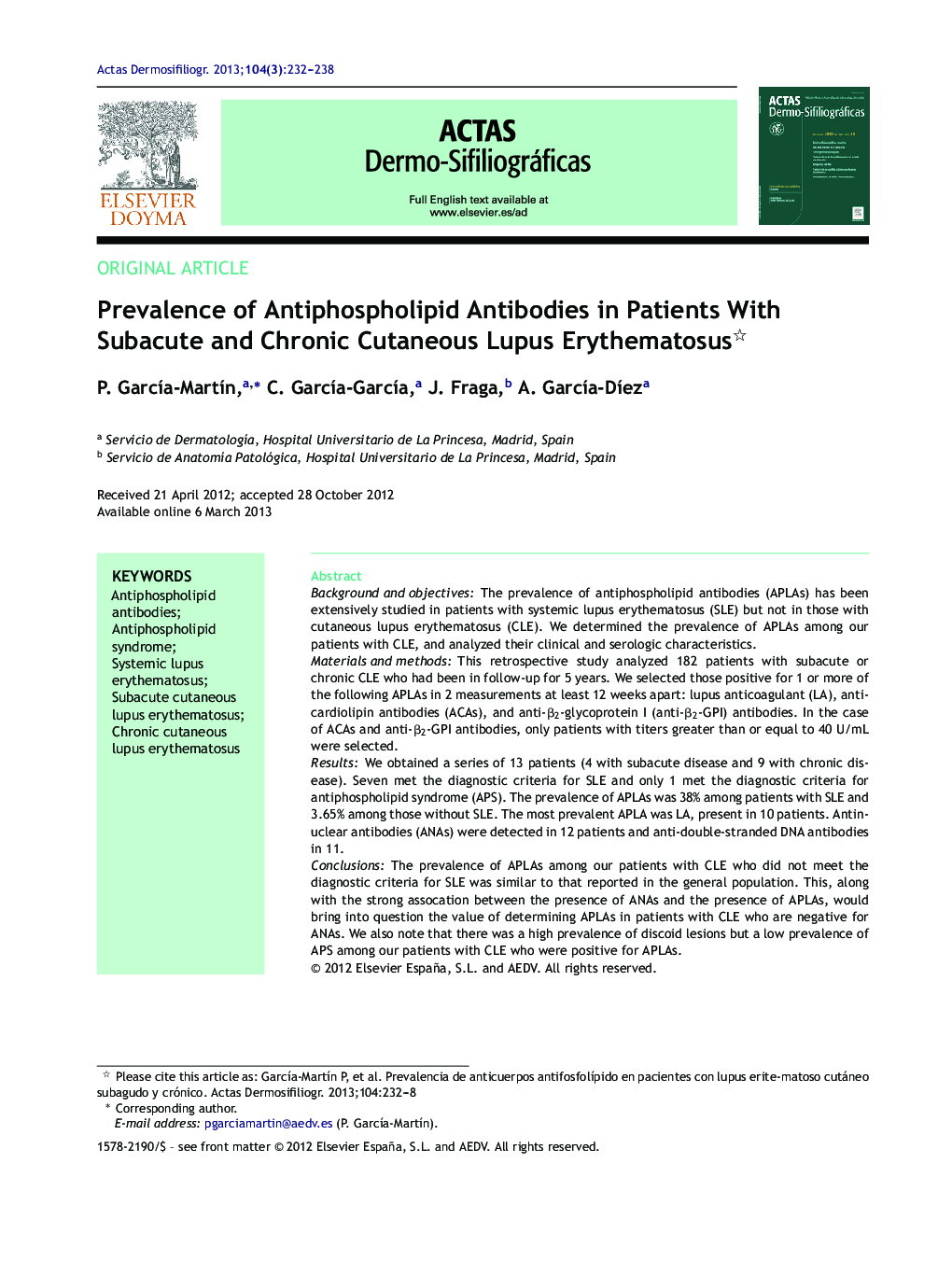| Article ID | Journal | Published Year | Pages | File Type |
|---|---|---|---|---|
| 3183195 | Actas Dermo-Sifiliográficas (English Edition) | 2013 | 7 Pages |
Background and objectivesThe prevalence of antiphospholipid antibodies (APLAs) has been extensively studied in patients with systemic lupus erythematosus (SLE) but not in those with cutaneous lupus erythematosus (CLE). We determined the prevalence of APLAs among our patients with CLE, and analyzed their clinical and serologic characteristics.Materials and methodsThis retrospective study analyzed 182 patients with subacute or chronic CLE who had been in follow-up for 5 years. We selected those positive for 1 or more of the following APLAs in 2 measurements at least 12 weeks apart: lupus anticoagulant (LA), anticardiolipin antibodies (ACAs), and anti-β2-glycoprotein I (anti-β2-GPI) antibodies. In the case of ACAs and anti-β2-GPI antibodies, only patients with titers greater than or equal to 40 U/mL were selected.ResultsWe obtained a series of 13 patients (4 with subacute disease and 9 with chronic disease). Seven met the diagnostic criteria for SLE and only 1 met the diagnostic criteria for antiphospholipid syndrome (APS). The prevalence of APLAs was 38% among patients with SLE and 3.65% among those without SLE. The most prevalent APLA was LA, present in 10 patients. Antinuclear antibodies (ANAs) were detected in 12 patients and anti-double-stranded DNA antibodies in 11.ConclusionsThe prevalence of APLAs among our patients with CLE who did not meet the diagnostic criteria for SLE was similar to that reported in the general population. This, along with the strong assocation between the presence of ANAs and the presence of APLAs, would bring into question the value of determining APLAs in patients with CLE who are negative for ANAs. We also note that there was a high prevalence of discoid lesions but a low prevalence of APS among our patients with CLE who were positive for APLAs.
ResumenIntroducción y objetivosLa prevalencia de anticuerpos antifosfolípido (AcAF) en pacientes con lupus eritematoso sistémico (LES) ha sido muy estudiada, pero no en pacientes con lupus eritematoso cutáneo (LEC). Determinamos la prevalencia de AcAF entre nuestros pacientes con LEC, y analizamos sus características clínicas y serológicas.Material y MétodosEstudio retrospectivo de 182 pacientes con LEC subagudo (LECS) o crónico (LECC) que se hallaban en seguimiento en los últimos cinco años. Seleccionamos a aquellos que presentaban uno o varios de los siguientes AcAF: anticoagulante lúpico (AL), anticuerpos anticardiolipina (ACA) y anticuerpos anti β2-glucoproteína I (anti-β2-GPI), en dos determinaciones, distanciadas al menos en 12 semanas. En el caso de los ACA y los anti-β2-GPI sólo se incluyeron pacientes con titulaciones iguales o superiores a 40 unidades por mililitro.ResultadosObtuvimos una serie de 13 pacientes: 4 fueron clasificados como LECS y 9 como LECC. Siete cumplían criterios de LES y sólo uno cumplía criterios de SAF. La prevalencia de AcAF fue del 38% entre los que cumplían criterios de LES, y del 3,65% entre los que no los cumplían. El AcAF más prevalente fue el AL, presente en 10 pacientes. Se detectaron Ac ANA en 12 pacientes y anti-dsDNA en 11.ConclusionesLa prevalencia de AcAF entre nuestros pacientes con LEC que no cumplían criterios de LES fue similar a la referida para la población general. Esto junto a la fuerte asociación de la presencia de ANA y AcAF cuestionaría la rentabilidad de determinar los AcAF en aquellos pacientes con LEC y ANA negativo. Además destaca que entre nuestros pacientes con LEC y AcAF existe una alta prevalencia de lesiones discoides y el desarrollo de SAF es poco frecuente.
